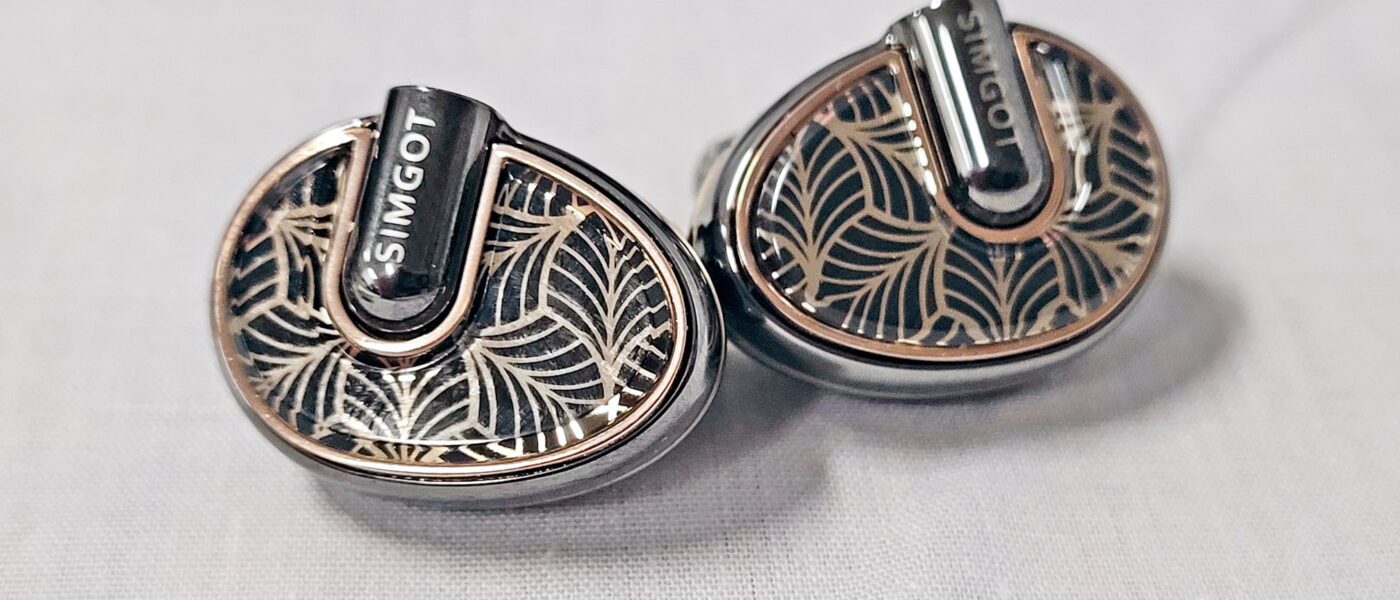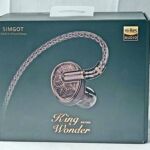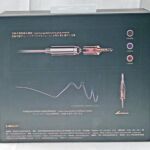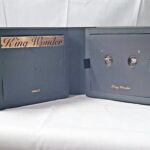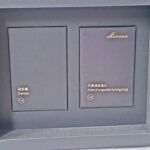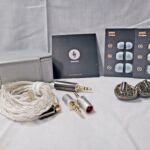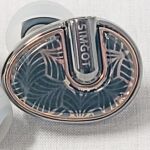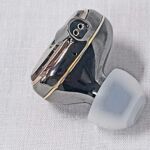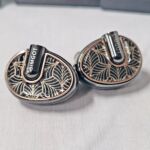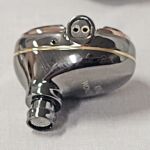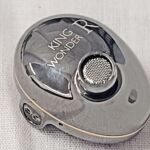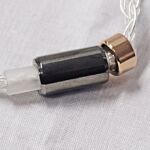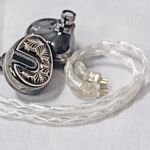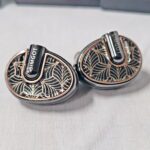Simgot EN1000 (King Wonder)
disclaimer: The Simgot EN1000 was provided by Simgot for the purpose of this review. I had previously reviewed several Simgot models as they were one of the companies that played a big role in the 1st generation of Chinese earphones to hit the market in the 2016 time frame. Simgot was ahead of its time then and started making upscale models that commanded higher prices at a time before Chinese brands were widely accepted as capable of competing at those higher price points. Their EK3 model sported 3 Knowles made balanced armatures with 4 tuning options and was really quite good, but was not as well accepted as I thought it should have been at the time. So while I admit a certain fondness for their earlier models, I have no financial interest in Simgot and have not received any guidance on this review. For more information on the EN1000 or other Simgot products, see their website.
Unboxing / Packaging:
The EN1000 comes shipped in a book-fold style box with a slip-cover with a solid left end so the box has to be slid out to the right-hand side. The box is split centrally with the manuals and case on the left and earpieces in foam on the top layer on the right-hand side. Under the earpieces are two additional boxes with tips, and tuning jacks neatly tucked inside. The cable is found inside the case to complete the ensemble. We’ll get into more detail on the jacks later in the write-up but for those looking at the picture and thinking they goofed and sent three 3.5mm jacks instead of 2.5mm or 4.4mm, that is not the case. The jacks are tuning options and contain a filter so each jack produces a slightly different signature. No balanced options were available at this time, but it does seem it should be possible to make additional types of filters and jacks should demand arise.
Build/Fit:
These are one good looking in-ear. The design is very reminiscent of earlier Simgot models, but the materials have been stepped up markedly with the polished metal and gold leaf design protected under a glass layer that give the outer surface a very high-polish look. The bi-pin connectors exit at middle front from a raised portion of the face and while standard cables will fit, the placement requires a cable with a more extended earhook in order to fit naturally so if trading cables, some additional shopping may be needed. The inner shell is equally well finished as it is machined aluminum that is then plated rather than anodized to give a super smooth finish that is comfortable in the ear. Size is moderate in width, slightly large in height, but shallow so most of the body sits gently on the ear with the nozzle having a distinct forward rake that allows the tip to sit in the ear canal firmly while most of the body sits behind it for increased comfort. The thin body and forward nozzle does limit isolation a bit but they still did a good job eliminating all but the loudest of outside noises when listening.
Internals:
The heart of the EN1000 is the latest generation of Simgot’s 10mm dynamic driver. This newest revision uses a beryllium and diamond like carbon coated diaphragm for increased rigidity while reducing weight compared to previous generations. The suspension has been redesigned as well and the driver utilizes a dual acoustic chamber design and dual cloth filters on the exit to help with tuning. In addition to the filters built into the earpiece, the modular jack system also doubles as a tuning filter with the EN1000 shipping with three filters and more options promised in months to come. Nominal impedance is 32Ω with a sensitivity of 108 dB/mW which puts the EN1000 in a class that is quite easy to drive and I had no issues using the EN1000 with dongles and other low powered sources. I did find that the EN1000 scaled nicely with better sources but the changes were more quantitative than qualitative.
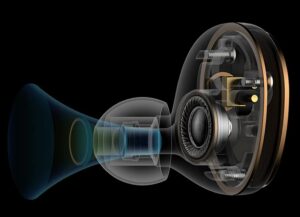
Cable:
The cable that ships with the EN1000 is quite interesting and different than most modular systems. It starts with a straight jack in a metal housing that matches the earpieces, unscrewing the housing allows removal of the jack and replacement with one of the others provided. So far that sounds pretty standard, but the options for replacement jacks include not only different sizes (2.5mm and 4.4mm are both now available directly from Simgot) but also to change the tuning of the EN1000 in the process. As the first drawing below shows, the jack housing actually is much more than a simple solder joint between jack and cable with electronic filters allowing Simgot to tune the sound. 4 plates at the back end of the jack housing contact the cable ends allowing for both balanced and single ended connectors to be used. The EN1000 ships with the 3.5mm version in 3 distinct tuning options and we are told the same options can also be had in 2.5mm and 4.4mm with additional tuning options coming soon. The cable itself is silver plated copper in a clear housing and uses a 8 wire braid up to the splitter (matched metal) and gold bead chin-slider where it branches to 4 wire braids up to the earhooks and clear housings for the 0.78mm bi-pin connectors.
Sound:
Bass:
Some will lament the lack of exaggerated bass as none of the tunings are bass heavy. I found the red jack a nice natural presentation with some rumble in the extreme lows and a bit more slam in the mid-bass. Mid-bass is quite quick with good detail and transients and no bleed or blur which gives the EN1000 a solid foundation without making the bass the star of the performance. I find this tuning much more natural for genres like classical and string ensembles where bass typically is not a major emphasis of the composition. For those listening to EDM and Hip-hop, the EN1000 may come across as a bit bass-lite.
Mids:
The mids are the star here with good lower-mids with no bleed or obstruction, good balance of note weight and energy. This gives lower voices a natural tonality without standing out artificially and still cutting through the other instruments enough to make listening easy. There is a mild climb as we move from the lower mids into the true mids which helps strings and gives piano good tonality. Guitar growl is good with enough rasp and edge to sound correct but a little more clarity than most so a little of the grunge seems a bit cleaned on some tracks. The good news is the textures in the mids are very good and transients quick which gives the mids a very detailed presentation. Upper voices have a large a push just below the 2kHz mark that do push them out in front and higher vocals will stand in front of lower voices as a result.
Treble:
The upper-mids peak and then drop back quickly as it moves into the lower treble which gives vocals a push without becoming fatiguing. There is good treble detail but again not exaggerated treble so snare rattle is good but cymbals may sound a little dull. It walks a fine line between enough top end to have cymbals sound good and becoming strident or fatiguing. There is some air at the top but again sparkle is limited in exchange for a more polite listen.
Soundstage / Imaging:
Stage is a bit wider than deep with some height but stops short of feeling fully 3d. Seating the orchestra is good with a slightly widened and flattened stage compared to the actual diagram. Instrument separation is good which helps and imaging is also quite good with placements being fairly tight. I found movements easily tracked around the stage but some break down of placements at the outside edges of the stage where instruments hover rather than continuing to move away. My compression tests found that even as tracks got busier and faster, the EN1000 maintained good clarity with no thickening or slurring of the lows.
Thoughts / Conclusion:
I am glad to see Simgot releasing new models as they were ahead of their time in the 1st wave of Chinese Hi-Fi and got punished for moving into the higher end space before the market was ready for the move. Their EK3 was way ahead of the curve and mine still gets used to this day. The EN1000 maintains their earlier design language but amplifies the materials and finishes used to produce a higher-end version of what we know Simgot for. Their driver has also seen the same treatment with improvements to the diaphragm and magnetic structure while retaining the earlier Simgot innovations in the design. The result is a gorgeous in-ear with some innovative features that make it unique to Simgot. I really like the balanced natural tonality of the EN1000 but wonder how far Simgot can go with the tuning filters to make the EN1000 appeal to those who want more bass presence. I’m also curious whether these new filters in the jack are specific to the driver used or if future models will have interchangeable filters that can also be used with the EN1000. The EN1000 raises the bar on what to expect from vendors at the price point as far as both kit contents and build quality, and the slightly vocal focused tuning is also a bit unique in the market and should help the EN1000 sell well.
-
Bass - 7/107/10
-
Mids - 7.5/107.5/10
-
Treble - 7/107/10
-
Soundstage - 7.5/107.5/10
-
Imaging - 7/107/10
Summary
Pros: Build is extremely good, good kit, innovative cable, balanced signature with good vocal presence
Cons: no balanced connectors, top end drops back above 7kHz and limits air at top

